FIA International Competition License
When working with FIA International Competition License, the official credential that lets drivers compete in FIA‑sanctioned events worldwide. Also known as FIA competition licence, it is issued after meeting strict medical, experience and training standards. The governing body, Fédération Internationale de l'Automobile, sets the global rules for motorsport and oversees the licensing process, ensures that each licence holder adheres to safety and performance guidelines. Driver licensing, covers the assessment of a racer’s skill level, physical fitness and track record is a key step, because without a valid licence you can’t enter any international competition. The licence also ties into competition regulations, the technical and sporting rules that define how a race is run, meaning every driver must stay updated on rule changes to stay eligible. In short, the FIA International Competition License enables participation, guarantees safety standards, and links drivers to the broader regulatory framework of motorsport.
Why the licence matters across racing categories
Whether you’re chasing podiums in Formula 3, battling it out in IndyCar, or testing limits in touring car series, the same licence acts as a passport. Racing categories, such as F3, IndyCar, GT and rally, each have specific performance caps and equipment rules rely on the licence to verify that drivers meet the appropriate skill tier. This creates a clear hierarchy: a driver with a basic competition licence might start in national club races, then upgrade to a higher‑grade licence for international F3 or IndyCar events. The process also demands continual medical checks; a lapse can suspend participation, which reinforces safety across all categories. Moreover, teams use licence status when selecting drivers, because it proves the racer has cleared the FIA’s stringent eligibility checks. So the licence not only opens doors, it also signals to teams, sponsors and event organizers that the driver is qualified and reliable.
Below you’ll find a curated list of posts that break down every aspect of the licence – from the paperwork and medical exams to how it fits into specific series like F3 or IndyCar. You’ll also see real‑world stories about drivers navigating the licensing ladder, tips on staying compliant with competition regulations, and insight into how the FIA’s rules shape today’s racing landscape. Dive into the collection and get the practical knowledge you need to understand, obtain, or maintain your FIA International Competition License.
- July 23, 2023
- Comments 0
- Motorsports and Racing
